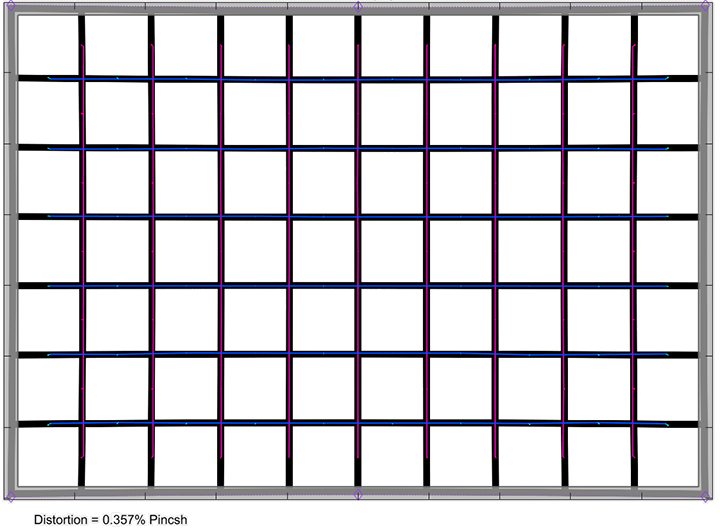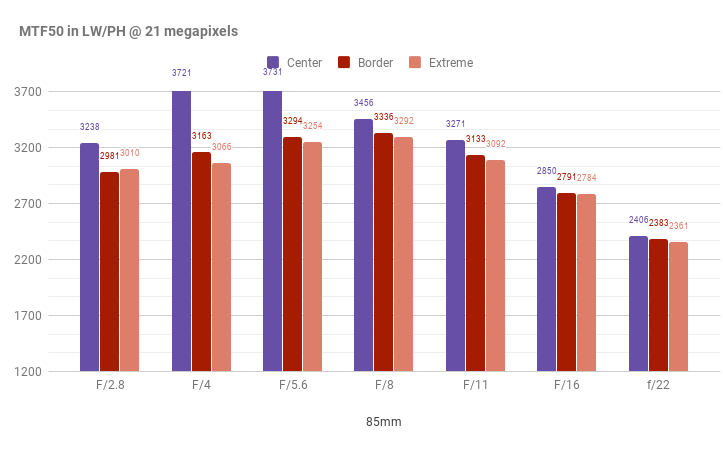|
Laowa 100mm f/2.8 2x Macro APO - Review / Test Report - Analysis |
|
Lens Reviews -
Canon EOS (Full Format)
|
|
Page 2 of 3

Distortion
Macro lenses tend to produce a very low level of image distortions - also because one of the typical applications are reproductions.
The Laowa 100mm f/2.8 2x Macro APO follows this tradition. It produces a slight pincushion distortion of 0.36%. While pincushion distortions
are generally less desirable, this shouldn't be a big deal in most scenarios.

Vignetting
The amount of vignetting (on a full format camera) is fairly high at f/2.8. A light falloff of more than 2.1EV (f-stops) is usually easily visible.
However, stopping down to f/4 reduces the vignetting to just under 1EV and it's not an issue anymore from f/5.6 onward.

MTF (resolution) on the EOS 5Ds R (at 50 megapixels)
The resolution characteristic of the Laowa lens is pretty impressive. The image center is already very sharp at f/2.8. The near-center quality isn't quite on the same
level here but it's still good to very good. The image borders/corners remain on that level. There's a tad less contrast at fully open aperture compared to f/4.
Stopping down improves the image quality somewhat especially in the center. At f/4 the center resolution reaches excellent levels and the near center quality
is boosted as well. The peak performance is reached between f/5.6 and f/8 where the borders/corners reach very good results. Diffraction effects reduce the quality
from f/11 onward but you should be able to achieve pretty good results even at f/16 - less so at f/22 (of course).
The centering quality of the tested sample was good. The field curvature is minimal.
Please note that the MTF results are not directly comparable across the different systems!
Below is a simplified summary of the formal findings. The chart shows line widths per picture height (LW/PH) which can be taken as a measure for sharpness.
If you want to know more about the MTF50 figures you may check out the corresponding Imatest Explanations

MTF (resolution) on the EOS 5D II (at 21 megapixels)
For the sake of comparison with our legacy tests, we are showing the MTFs taken at 21 megapixels below. Unsurprisingly they are even "better" on pixel level here with no relevant weakness across the aperture range.

Chromatic Aberrations (CAs)
Lateral CAs are moderate with a max. average pixel width at the image borders of around 1.5px at f/2.8. The CAs decrease the more you stop down and they are negligible at f/11 and beyond.
You may debate whether this is too much for a lens that claims to be APO(-chromatic) but it's mostly a non-issue in real life.

Bokeh
Lenses should be sharp, of course, but especially macro lenses should have a nice bokeh (rendering of the out of focus blur) because there's pretty much always some image portion out of focus whenever you enter the realm of macro photography. The Laowa 100mm f/2.8 2x Macro APO does a pretty good job here.
The sample crop below illustrates the blur just beyond the focus point - shown to the left - and in front of it - shown to the right. The background blur is smooth with just a slight unevenness. The foreground blur is slightly more busy with a hint of a double halo (see the nose of the king to the right).
 The Laowa lens boasts 9 aperture blades in EOS mount (and 13(!) in Sony FE mount) which is standard in this lens class. Out of focus highlights are pretty much perfect at f/2.8 and (mostly) f/4. However, an edgy aperture shape can already be seen at f/5.6. As usual, the circular shape of the highlights deteriorates towards the borders/edges of the image field (at large aperture settings).
The Laowa lens boasts 9 aperture blades in EOS mount (and 13(!) in Sony FE mount) which is standard in this lens class. Out of focus highlights are pretty much perfect at f/2.8 and (mostly) f/4. However, an edgy aperture shape can already be seen at f/5.6. As usual, the circular shape of the highlights deteriorates towards the borders/edges of the image field (at large aperture settings).

Bokeh Fringing
As the name implies, the Laowa 100mm f/2.8 2x Macro APO is marketed as an "APO" (apochromatic) lens thus we were curious whether the lens can correct axial chromatic aberrations (on the Z-axis that is).
And yes, there is barely any visible fringing (coloured halos around high contrast transitions) which is pretty unusual and quite impressive actually.
If you scroll through the provided aperture range, you may also notice that the focus point remains constant - thus there are no relevant residual spherical aberrations either.
|